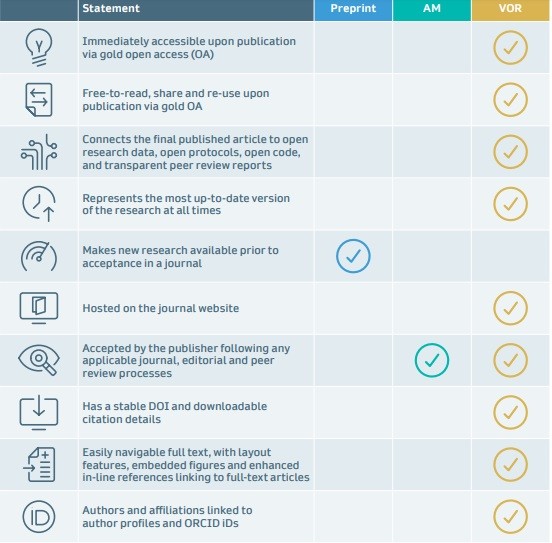When it comes to article type, researchers prefer the VOR
To what extent does article version matter to researchers? And how does it impact the way a researcher might discover, read, cite or share research output? Mithu Lucraft discusses our latest whitepaper and unpacks why researchers prefer the version of record compared to accepted manuscripts and preprints.
In scholarly publishing, there are often multiple versions of an author’s research available online, prior to and after publication in a journal. A preprint, also known as an author’s original manuscript, is the version of an article that precedes any formal peer review. Accepted Manuscripts (AMs) are versions that have been through any applicable journal’s editorial and peer review processes and have been accepted for publication by a journal and / or publisher. The version of record (VOR) is the final edited and formatted version of an article made available by the publisher in a journal, maintained after publication and dynamically updated in perpetuity.
What do researchers make of having so many different versions available? Do they use different versions for different purposes? Is the final published version - the VOR - significantly more valuable to them? To help answer some of these questions we have released a white paper which shows convincing evidence that researchers prefer the VOR. We worked in collaboration with ResearchGate to examine usage of PÕ¾ÊÓƵ articles on the ResearchGate platform, alongside a survey of readers. We wanted to know does usage of VORs differ from author uploaded content on ResearchGate (e.g. AMs or preprints)? And do users prefer one version of an article over another?
What we found is that researchers overwhelmingly prefer the VOR both for general reading and for research, with them regarding this version as the most authoritative and credible source 1. Looking at usage of PÕ¾ÊÓƵ content on ResearchGate, where users have access to both earlier versions (AMs or preprints) and the final published VOR, they are more likely to use the VOR. Where articles were open access (OA), we saw the highest usage of the VOR, with fewer than 5% accessing earlier versions of the article 2.
We also surveyed nearly 1,400 researchers reading PÕ¾ÊÓƵ articles on ResearchGate. For general reading, reading to inform their own work, and for citing, researchers overwhelmingly preferred the VOR over AMs and preprints. This was highest for citing, with 83% preferring to work with the VOR for citing content 3. In open text comments, researchers pointed to the ‘stamp of credibility’ that the VOR has, being published in a recognised journal and including post-accept improvements such as copy editing, type setting, the inclusion of figures and links to data, and continued maintenance after publication.
In fact where researchers don’t have access to the VOR (i.e. they don’t have access via a subscription or as a result of it being published OA), the majority - nearly 9 in 10 researchers - will take at least one action to gain access to the VOR, showing how much value they place on this version 4.
This, therefore, further supports why advocates of the gold OA model, including PÕ¾ÊÓƵ, see the availability and financial support of the VOR via gold OA as so crucial. The VOR is a fundamental building block of open science - immediately available on publication, it provides researchers with easy to navigate full text, embedded figures, supplementary information and extended data. With downloadable citation details, article-level metrics, enhanced reference lists with links to articles or full-text, and links to corrections and additional commentaries also available as part of the VOR, these dynamic and enhanced features provide researchers with the full and complete reading experience to use and build upon in their own work. Compare this to green OA which makes AMs available, typically after an embargo period. AMs do not include any post-accept improvements, do not link to data or code, and do not show corrections or retractions. As such, green OA provides access to potentially inferior versions of an article, with limited permissions for re-use.

Importantly, this new research shows that green OA, and attempts to widen the availability of AMs, does not reflect researcher preference, and if anything that further investment in the AM and green OA, either financially (for example investment in AM infrastructure or discoverability services) or by policies, is not, in the long run, a sustainable or desirable option. It may in fact be detrimental in the drive to grow access to the VOR via the gold OA route, thereby delaying or preventing a full and complete transition to open research and therefore the wider goal of open science.
With clear preference by researchers for the VOR, we call for a continued and coordinated effort to grow OA, and access to the VOR, enabling not only access to the research article but every facet of research openly and immediately available, accessible, and reusable by all.
Footnotes
1.Lucraft, Mithu; Allin, Katie; Batt, Imogen (2021): Exploring researcher preference for the version of record. figshare. Journal contribution. Pg.4. Pg.10-11. https://doi.org/10.6084/m9.figshare.13834532.v1
2. Lucraft, Mithu; Allin, Katie; Batt, Imogen (2021): Exploring researcher preference for the version of record. figshare. Journal contribution. Pg.3. Pg 13-15. https://doi.org/10.6084/m9.figshare.13834532.v1
3. Lucraft, Mithu; Allin, Katie; Batt, Imogen (2021): Exploring researcher preference for the version of record. figshare. Journal contribution. Pg.3, Pg 13-15. https://doi.org/10.6084/m9.figshare.13834532.v1
4.Lucraft, Mithu; Allin, Katie; Batt, Imogen (2021): Exploring researcher preference for the version of record. figshare. Journal contribution. Pg.4, PG.14. https://doi.org/10.6084/m9.figshare.13834532.v1



